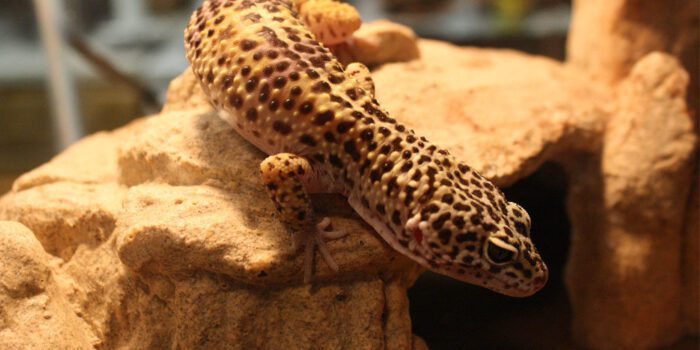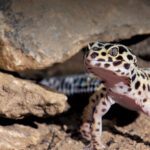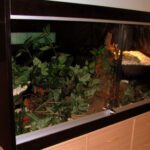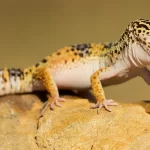Leopard geckos are naturally shy and retiring reptiles that love to have access to hiding spaces where they can retreat and feel secure. In the wild, leopard geckos hide under rocks, in burrows, and in crevices and cracks in the landscape. As pets, they still have this strong instinctual need to hide, so it’s important to provide them with appropriate hide boxes and shelter areas in their vivarium habitat. In this article we talk about Leopard gecko hide areas and hide boxes.
Hide boxes and shelter areas serve several key functions for leopard geckos:
- Provide a sense of security and allow them to feel less stressed. Leopard geckos are prey animals by nature and being exposed often causes fear and apprehension. Access to hiding spaces helps them feel comfortable and confident to come out into the open areas of the enclosure to bask, explore and feed.
- Give opportunities for undisturbed rest and sleep. Leopard geckos are crepuscular meaning they are most active at dawn and dusk. During the day, they need a dark hiding area for uninterrupted sleep.
- Allow privacy and seclusion during shedding. When shedding, leopard geckos become even more sensitive and vulnerable. Hide boxes give them a quiet private space to complete the shedding process.
- Create temperature and moisture refuges. The temperature and humidity can vary across different areas of the vivarium. Hide boxes located over the warm end provide warmer temperatures while those situated over the cool end provide more humidity.
- Provide territorial spaces and boundaries. In the wild, leopard geckos establish well-defined home ranges and territories. Hide boxes and shelters help define spaces within their captive enclosures as well.
Table of Contents
Choosing Appropriate Hide Boxes
There are many options when it comes to hide boxes and shelters for leopard geckos. The most important criteria are that they provide darkness and snugness inside while allowing easy access.
Natural Hide Boxes
Pieces of cork bark, curved tiles, clay plant pots laid on their sides, and coconut shells are all examples of naturalistic hides. These options blend into the décor nicely while still functioning well as hiding spaces. Look for pieces that allow your leopard gecko to fit their entire body inside and touch the sides while sleeping or resting.
Commercial Reptile Hides
Many commercial reptile products are designed specifically with the needs of leopard geckos in mind. They cater to key behaviors like burrowing and climbing with shapes like caves, tubes and half-logs. These products are lightweight, easily cleaned, pet-safe and provide both form and function.
Homemade Hides
For the crafty herper, DIY hide boxes are fun to create. Pieces of bark, driftwood, and slate make for very natural looking hides. Clay and plastic plant saucers also work nicely, especially when buried in the substrate. Be sure that any homemade hides have smooth, non-toxic surfaces and at least one entrance hole of appropriate size for your leopard gecko.
Important Features of Hide Boxes
- Completely enclosed (except for the entrance) to give a sense of security and privacy
- At least one entrance/exit large enough for the gecko yet small enough to also feel snug inside
- High enough for the gecko to raise its head and move around a little while inside
- Substrate underneath that allows for burrowing down inside
- Positioned with the opening facing toward the warm area of the enclosure
Hide Areas Within the Vivarium
Design In addition to discrete hide boxes, the overall vivarium design itself should contain areas for the leopard gecko to feel concealed and sheltered within habitat furnishings. Consider the following types of shelters within the habitat landscape:
Under Decor Items
Flat pieces of natural stone, cork tiles, sections of bark or driftwood elevated on sturdy decor items like reptile cage décor provide shaded areas underneath for leopard geckos to hide under. These help enrich the habitat by allowing for more choices.
Between Decor Items
Leaning pieces of Mopani wood or curved cork bark against each other creates little nooks and tunnels. Leopard geckos enjoy peering out from these small spaces while still feeling hidden.
Among Plants
Live or artificial plants help create a naturalistic environment with areas of visual blockade. Strategically place plants to allow for concealed paths and hiding spots within the foliage. Plants also help shelter the soil substrate which is used for burrowing.
In Substrate
A ground cover substrate at least 3 inches deep supports a leopard gecko’s natural digging and burrowing instinct. Locate a deeper section of 5-6 inches at one end to allow extra burrowing opportunity. Add hide boxes with buried lower halves or tube hides to create tunnels in the substrate.
Over the Warm
And always be sure to place most hide opportunities at the warm end of the temperature gradient since leopard geckos spend most of their time in these warmer areas when not basking out in the open. Providing ample hide access here allows them to thermoregulate properly.
Number of Hiding Spaces
In general, provide a bare minimum of one warm humid hide, one cool humid hide and one additional non-humid hide. However, the more options, the better. Shoot for a minimum of three hides but ideally give your leopard gecko at least five dark enclosed tight spaces to retreat to. More confident outgoing geckos may not use all of them but they will provide comfort knowing they are available if needed.
Some key takeaways when providing hide boxes and shelter areas:
- Leopard geckos instinctively need and seek out spaces to hide and feel secure
- Well-chosen hides allow leopard geckos to rest comfortably and privately
- Both standalone hide boxes as well as integrated vivarium decor can offer concealment
- Hide opportunities are especially important over the warm area used most frequently
- Provide a minimum of three hide boxes but the more options available, the better
By keeping a leopard gecko’s strong hiding instinct in mind and providing ample enclosed spaces distributed through the habitat layout, you can keep your leopard gecko feeling right at home in its vivarium. Hides allow this wonderful reptile pet to thrive both behaviorally and physically. I hope you find this “Leopard gecko hide areas and hide boxes” article helpful.




